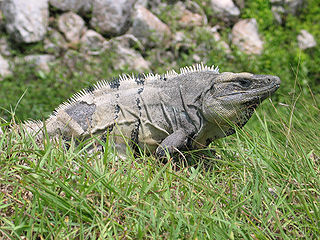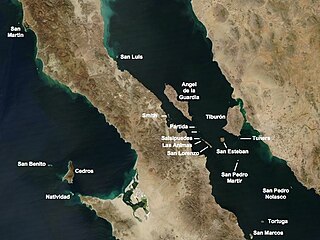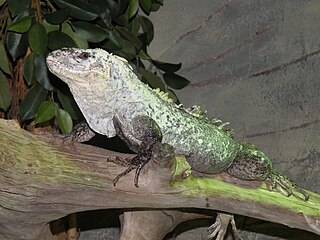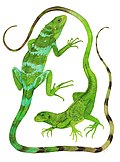
Ctenosaura is a lizard genus commonly known as spinytail iguanas or ctenosaurs. The genus is part of the large lizard family Iguanidae and is native to Mexico and Central America. The name is derived from two Greek words: κτενός, meaning "comb", and σαύρα, meaning "lizard".

Masticophis is a genus of colubrid snakes, commonly referred to as whip snakes or coachwhips, which are endemic to the Americas. They are characterized by having a long, thin body and are not dangerous to humans.

Ctenosaura pectinata is a species of moderately large lizard in the family Iguanidae. The species is native to western Mexico.

San Esteban Island is a small island in the Gulf of California, Mexico, located to the southwest of Tiburón Island. It is part of the Municipality of Hermosillo in Sonora and has a land area of 39.773 km2, the 15th-largest island in Mexico. It is located in the Gulf of California. It was once inhabited by a group of the Seri people.

Ctenosaura bakeri, also known as the Utila spiny-tailed iguana, Baker's spinytail iguana, swamper or wishiwilly del suampo, is a critically endangered species of spinytail iguana endemic to the island of Utila, one of the Islas de la Bahía off the coast of Honduras in the Caribbean.
The Campeche spiny-tailed iguana is a species of lizard in the family Iguanidae. The species is native to southeastern Mexico and adjacent Guatemala.
Ctenosaura clarki, commonly known as the Balsas armed lizard, Balsas spiny-tailed iguana, Michoacán dwarf spiny-tailed iguana, or nopiche, is a species of lizard in the family Iguanidae. The species native to Mexico.

The Yucatán spiny-tailed iguana is a species of lizard in the family Iguanidae. It is endemic to northern Yucatán, Mexico.

Ctenosaura melanosterna, commonly known as the black-chested spiny-tailed iguana or Honduran spinytailed iguana, is a species of iguana in the genus Ctenosaura. It is considered endangered.

Ctenosaura oaxacana, commonly known as the Oaxacan spiny-tailed iguana, is a species of lizard in the family Iguanidae. It is endemic to Mexico.

Ctenosaura quinquecarinata, commonly known as the Oaxacan spinytail iguana or the five-keeled spiny-tailed iguana is a species of lizard in the family Iguanidae native to Central America.

Ctenosaura similis, commonly known as the black iguana or black spiny-tailed iguana, is an iguanid lizard native to Mexico and Central America. It has been reported in some Colombian islands in the Caribbean Sea and Pacific Ocean, and has been introduced to the United States in the state of Florida. The largest species in the genus Ctenosaura, it is commonly found in areas such as grasslands and forests.

The San Esteban chuckwalla, also known as the piebald chuckwalla or pinto chuckwalla, is a species of chuckwalla belonging to the family Iguanidae endemic to San Esteban Island in the Gulf of California. It is the largest of the five species of chuckwallas, and the most threatened.

Ctenosaura hemilopha, also known as the Baja California spiny-tailed iguana, is a species of spinytail iguana endemic to Baja California. It is arboreal and primarily herbivorous, although it can be an opportunistic carnivore. Males may grow up to 100 centimeters (39 in) in length, while females are smaller, with a length of up to 70 centimeters (28 in). Five subspecies are currently recognized.

Ctenosaura acanthura, is a species of iguanid lizard found in eastern Mexico and extreme western Guatemala. The standardized English name is the Mexican spiny-tailed iguana. Confusingly however, an earlier edition of standardized names for Mexican herpetofauna called Ctenosaura acanthura the northeastern spinytailed iguana and applied the name Mexican spinytailed iguana to Ctenosaura pectinata, which was called the western spiny-tailed iguana in the second edition. It has also been referred to as the Veracruz spiny-tailed iguana and Gulf Coast spiny-tailed iguana. It is an egg laying species that is mostly herbivorous and a moderately large lizard commonly growing over one meter in total length.

The Guatemalan beaded lizard, also called commonly the Motagua Valley beaded lizard, is a highly endangered species of beaded lizard, a venomous lizard in the family Helodermatidae. The species is endemic to the dry forests of the Motagua Valley in southeastern Guatemala, an ecoregion known as the Motagua Valley thornscrub. It is the only allopatric beaded lizard species, separated from the nearest population by 250 km (160 mi) of unsuitable habitat. The Guatemalan beaded lizard is the rarest and most endangered species of beaded lizard, and it is believed that fewer than 200 individuals of this animal exist in the wild, making it one of the most endangered lizards in the world. In 2007, it was transferred from Appendix II to Appendix I of CITES due to its critical conservation status.
Gunther Köhler is a German herpetologist. His research is primarily focused in Central America and in the West Indies.

Cachryx is a genus of lizards in the family Iguanidae, native to the Mexico's Yucatán Peninsula and adjacent Guatemala.

Ctenosaura macrolopha, the Sonoran spiny-tailed iguana or Cape spinytail iguana, is a species of iguana native to Mexico.
Ctenosaura nolascensis, the Nolasco spiny-tailed iguana or San Pedro Nolasco spinytail iguana, is a species of iguana native to Mexico. It is endemic to one island, the Isla San Pedro Nolasco.

















